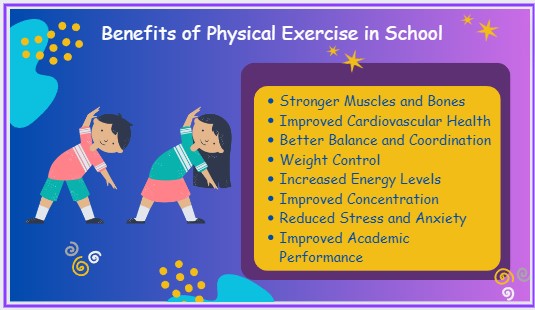The Importance of Physical Exercise in a School Setting
Physical Exercise (PE) is an important part of a healthy lifestyle and should be incorporated into the daily routine of all students. Physical activity in a school setting has a wide range of benefits. Physical exercise provides many benefits to students of all ages, from improved physical health and mental well-being to increased academic performance and better social skills.
It improves physical health, mental health, and cognitive abilities. It also benefits reducing stress levels and improving academic performance. Regular physical exercise promotes increased energy levels, improves socialization, and develops leadership skills. In addition, physical exercise helps improve the overall school climate, fosters a sense of community, and promotes healthy habits that last a lifetime.

In this blog, on behalf of The Manthan School, Noida, we will guide you through our insights on why physical exercise is so important in a school setting and the various ways it benefits students.
Exercise supports students to stay active and healthy, leading to better concentration and improved academic performance. It also aids in promoting physical fitness, which is important for students to maintain a healthy lifestyle. Exercise helps students develop better coordination, balance, and strength, which helps them be more successful in physical activities. Additionally, physical exercise backs increase self-esteem and improve mental health, as it assists students in managing stress and anxiety. Finally, physical exercise is an excellent way for students to bond with their classmates and build relationships.
Firstly, let’s learn about the physical benefits of exercise in schools.
Physical Benefits of Exercise in Schools
Exercise is an essential part of a healthy lifestyle, and children need to engage in physical activity as they grow. Exercise has numerous physical benefits, and when it is incorporated into a student’s school day, these benefits become even more pronounced. Here are just a few of the physical benefits of exercise in schools.
Stronger Muscles and Bones
Exercising regularly assists children in building strong muscles and bones. Regular physical activity supports increased bone density, which is essential for preventing bone-related illnesses like osteoporosis later in life. Furthermore, strength training aids children to develop strong muscles which help protect them from injuries.
Improved Cardiovascular Health
Exercising regularly helps improve a child’s cardiovascular health. Cardiovascular exercise strengthens the heart and lungs, which improves a child’s overall fitness level and reduces their risk of developing cardiovascular diseases in adulthood.
Better Balance and Coordination
Physical activities, such as yoga, tai chi, and martial arts, help improve a child’s balance and coordination. Balance and coordination are important for everyday tasks like walking, climbing stairs, and playing sports. Furthermore, these activities benefit children in learning how to control their bodies and improve their posture.
Weight Control
One of the most important physical benefits of exercise in schools is weight control. Regular physical activity assists children in maintaining a healthy weight, which aids reduce their risk of obesity and its associated health risks. Furthermore, exercise pi children learn healthy eating habits, which help them maintain a healthy weight throughout their lives.
Increased Energy Levels
Exercise makes children feel energized and alert. When children exercise, their bodies release hormones that help to reduce stress and improve their mood. Furthermore, exercise improves a child’s sleep quality, which keeps them feeling more alert during the day.
Exercise provides numerous physical benefits for children. When incorporated into a student’s school day, these benefits become even more pronounced. Therefore, schools must provide adequate physical education and exercise opportunities for their students.
Along the same line, there are some mental benefits of exercise in schools as well. Let’s discuss this.
The Mental Benefits of Exercise
Exercise has long been known to have physical benefits, but it also has profound mental benefits, especially when done in schools. Exercise has been found to help improve concentration, reduce stress and anxiety, improve self-esteem, and improve overall mental health.
Improved Concentration
The first benefit of exercise in schools is improved concentration. Regular physical activity benefits students to focus and pay attention in class. This is especially important for students who have trouble concentrating in school. Exercise encourages them to become more motivated and engaged in their studies. Exercising also assists to increase oxygen to the brain, which improves mental alertness and reduces fatigue.
Reduced Stress and Anxiety
The second benefit of exercise in schools is reduced stress and anxiety. Exercise assists students to manage their stress and anxiety levels, as it decreases levels of the stress hormone cortisol. Exercise also releases endorphins, which are natural feel-good hormones that help to improve mood and reduce anxiety.
Improved Academic Performance
The third benefit of exercise in schools is improved self-esteem. Exercise benefits by boosting self-confidence and self-esteem, which leads to improved academic performance. Exercise also aids in reducing feelings of depression and loneliness, which is especially beneficial to students who are struggling with mental health issues.
Overall Mental Health
The fourth benefit of exercise in schools is improved overall mental health. Regular physical activity helps reduce symptoms of depression, and it also aids in preventing mental health conditions from developing. Exercise maintains reduced feelings of stress, anxiety, and low self-esteem, which supports improving overall mental health.
Despite the numerous physical and mental benefits of exercise, many schools are not taking the necessary steps to ensure that students are getting adequate physical exercise.
Let’s discuss how schools should encourage physical exercise and its many benefits.
How Schools Should Encourage Physical Exercise
PE is a critical component of education as it helps children develop healthy habits for life and sets them up for success physically and mentally. Schools should encourage physical exercise in several ways, such as providing physical education classes, promoting outdoor activities, and incorporating physical activities into the school day. By taking a proactive approach to physical exercise, schools help foster a healthier and more active student body.
Access to PE Classes and Program
One way schools should encourage physical exercise is by providing students with access to physical education classes and programs. Physical education classes include activities such as running, jumping, throwing, swimming, and other forms of physical activity. Schools should also provide access to equipment such as treadmills, stationary bikes, ellipticals, and other exercise machines.
Incentivize the PE Activities
Another way to encourage PE is to offer incentives to students who participate in physical education classes or other physical activities. Schools offer rewards such as extra credit, special privileges, or discounts on school supplies. This helps to motivate students to become more active and make physical activity part of their daily routine.
Sponsor Outdoor Activities
In addition to providing access to physical education classes and equipment, schools should promote physical activity through extracurricular activities. Schools should offer a variety of activities such as sports teams, dance teams, and outdoor activities that allow students to get into some physical activity. This helps to create a culture of exercise and healthy living in the school.
Include in a Curriculum
Finally, schools should make physical activity a part of the curriculum. Schools should incorporate physical activities into the lesson plans for various subjects. This helps to keep students engaged and motivated to be active.
Schools should take the necessary steps to ensure that students are getting an adequate atmosphere, a culture of exercise, and healthy living. These steps assist students to be more productive in their studies and lead healthier lives.
Conclusion
The impact of PE in school on academic performance, physical health, and mental health is far-reaching and profound. Studies have shown that physical activity improves academic performance by increasing concentration, focus, and retention of information. Furthermore, physical exercise enhances physical health by improving physical strength, and flexibility, and reducing the risk of developing chronic illnesses.
Lastly, physical exercise improves mental health by reducing stress, improving self-confidence, and promoting healthy social relationships. The benefits of physical exercise in school are manifold and should not be overlooked.
We at The Manthan School, Greater Noida West, give utmost importance to physical exercise as a part of our curriculum to support students to excel in life. For more information, visit our website: www.themanthanschool.co.in/ or feel free to write to us at info.ne@manthan.edu.in or admission.ne@manthan.edu.in.
